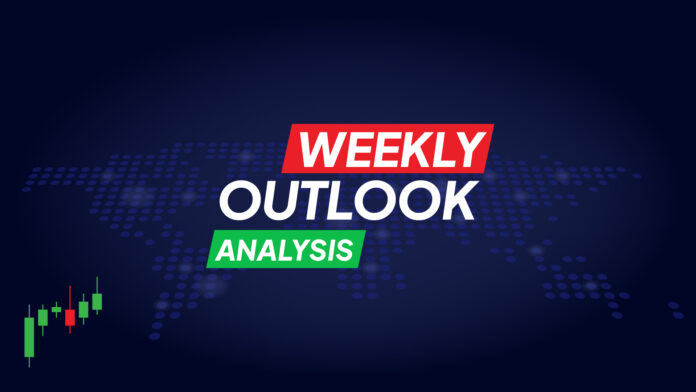Key points to watch out for:
- Investors are debating between a Fed rate cut of 25 or 50 basis points
- The Bank of England is expected to remain unchanged, but resume cuts in November.
- The Bank of Japan will also remain on hold and focus on signals of future rate hikes.
Let the Fed’s Rate Cuts Begin
Since the July U.S. jobs report sparked fears of a possible economic recession, investors have been trying to determine the magnitude of the Fed’s potential rate cut at its September meeting. Now, the long-awaited moment has finally arrived. On Wednesday, September 18, the Fed will announce its decision, and the question is not whether officials will cut rates, but by how much. Essentially, the focus is on how many basis points they will lower the federal funds target rate.
After Chairman Powell’s speech in Jackson Hole, where he indicated that further weakness in the labor market would not be tolerated, investors focused on employment-related data. They increased their bets on rate cuts at any sign of weakness. The August NFP report was not as positive as forecast, leading investors to see about a 30% chance of a 50 basis point rate cut at this week’s meeting. That percentage dropped to 15% after the August CPI data showed core inflation remains high, well above the Fed’s 2% target. However, it rose to 45% after the Financial Times and the Wall Street Journal reported that this week’s decision would be very close.
However, with the Atlanta Fed’s GDPNow model projecting a solid 2.2% growth rate for the third quarter, there appears to be no concrete reason for policymakers to begin this easing cycle with an aggressive move. A 25 basis point cut seems most likely. If this is the scenario, the dollar could rise, as those hoping for a larger cut may be disappointed. However, whether the dollar can hold its gains may depend on the updated dot plot and Powell’s comments regarding the Committee’s future actions.
If the dot plot and Powell indicate fewer basis point reductions this year than the 115 currently anticipated by the market, the dollar could strengthen further. Regarding Wall Street, confidence that the world’s largest economy is not headed for a recession may keep risk appetite elevated, even if this results in fewer rate cuts than previously expected. On Tuesday, September 17, U.S. retail sales will be released, although, given the significance of the Fed meeting, it is unlikely to greatly influence investor sentiment.
Will the Bank of England Confirm November Cut Bets?
On Thursday, September 19, attention will shift to the Bank of England. At its last meeting, the Bank cut interest rates by 25 basis points, although the decision was close, with officials hinting they will be cautious in future reductions. Since then, data has supported the officials’ stance. PMIs beat forecasts in both July and August, while the labor market continued to improve. Although average weekly earnings continued to slow, they were firmer than expected, with the year-over-year rate in July remaining at 5.1%. Additionally, headline CPI rebounded somewhat in July, despite services inflation remaining high. August inflation figures will be released on Wednesday, September 18, while retail sales will be released on Friday, September 20.
Although Bank of England Governor Andrew Bailey stated in Jackson Hole that they are in no hurry to cut rates again, market participants estimate an 80% chance that no action will be taken at this meeting. The remaining 20% chance of a rate cut could be due to concerns over stagnant monthly GDP in July. If officials decide against cutting rates, investors will focus on the Bank’s communication about its plans. According to the UK’s Overnight Index Swaps (OIS), investors expect two more quarter-point cuts at the November and December meetings. However, if policymakers maintain a cautious approach, the pound may sustain its recent rally.
A Strong Yen Awaits the Bank of Japan’s Decision
On Friday, September 20, the Bank of Japan will make its next policy decision. In July, the bank’s policy makers raised interest rates by 15 basis points and have since hinted that more hikes are on the horizon. This has led investors to estimate an 85% likelihood of another 10 basis point hike by the end of the year.
Although Bank of Japan officials have repeatedly stated that the pace of rate hikes may be slow, the divergence in monetary policy strategies between the BoJ and the rest of the world has led to a rally in the yen, as traders have decided to abandon a previously saturated carry trade. However, no policy action is expected during this meeting, so the focus will be on whether Ueda and his colleagues will continue to signal further hikes in the future. Any indication that supports the market’s view of another hike before the end of the year could strengthen the yen.
In the hours leading up to the decision, the August national CPI figures will be released.
Canadian Inflation and Summary of the Bank of Canada’s Deliberations
On Tuesday, September 17, CPI inflation data for August will be released in Canada. At its meeting a few weeks ago, the Bank of Canada (BoC) cut interest rates for the third consecutive time, paving the way for possible further cuts if the economy slows sharply in the future. On Wednesday, September 18, the summary of the Bank’s deliberations may provide further clarity on this, but a further cooling in consumer prices the day before could encourage market participants to increase their rate-cut bets. They currently estimate another 60 basis point cut between now and the end of the year. On Friday, September 20, Canadian retail sales data will be released.
Finally, in Australia, the August employment report will be released on Thursday, September 19.



